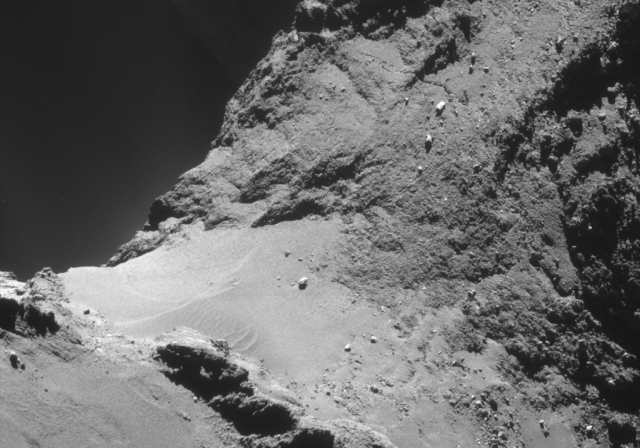Comet 67P/C-G’s surface at less than 1 meter resolution

Taken at less than five miles from the surface, Rosetta’s newest images of Comet 67P/C-G are close enough to resolve objects as small as two feet across.
The image is of the comet’s narrow neck, and shows two very interesting features.
First the dunes. In the sandy smooth area you can see dune-like ripples, almost as if a wind had been blowing across the sand. Though the comet has no permanent planetary atmosphere (it is too small), it does have a temporary atmosphere produced as material vents away when the comet approaches the Sun and heats up. This temporary atmosphere apparently can blow across the sand and create dunes.
Next is the fracture-like features in the darker material to the top of the image. The biggest fracture line appears to be a meandering line that is traveling from the image’s top center to its mid-right. There also appear to be parallel lines below it. As we are looking at the nucleus’s neck, these lines suggest that the connection between the two large lobes is somewhat strained, and that it is not unlikely that these two sections will break apart at some time in the future. Though there is no way to predict at this time when that will happen, it will be truly exciting if it happens when Rosetta is in the neighborhood.
On Christmas Eve 1968 three Americans became the first humans to visit another world. What they did to celebrate was unexpected and profound, and will be remembered throughout all human history. Genesis: the Story of Apollo 8, Robert Zimmerman's classic history of humanity's first journey to another world, tells that story, and it is now available as both an ebook and an audiobook, both with a foreword by Valerie Anders and a new introduction by Robert Zimmerman.
The print edition can be purchased at Amazon or from any other book seller. If you want an autographed copy the price is $60 for the hardback and $45 for the paperback, plus $8 shipping for each. Go here for purchasing details. The ebook is available everywhere for $5.99 (before discount) at amazon, or direct from my ebook publisher, ebookit. If you buy it from ebookit you don't support the big tech companies and the author gets a bigger cut much sooner.
The audiobook is also available at all these vendors, and is also free with a 30-day trial membership to Audible.
"Not simply about one mission, [Genesis] is also the history of America's quest for the moon... Zimmerman has done a masterful job of tying disparate events together into a solid account of one of America's greatest human triumphs."--San Antonio Express-News


Unbelievable. Are these black and white photos, or is the comet itself totally colorless?
These are black and white images, as the camera, NAVCAM, is designed to provide navigational information first and foremost. However, if the images were in color we would not see that much different. The comet is like most asteroids, extremely dark, like soot. They have to do a lot of massaging to bring out these details. The link above explains this in detail.
Fortuitously, Robert has already found the answer for the next question: why does NASA use black and white cameras on space probes?
http://behindtheblack.com/behind-the-black/points-of-information/the-reason-why-nasas-planetary-probes-still-use-black-and-white-photography/
To sum up:
“grayscale images are often more useful for research. … when the goal is to study the shape of the surface, measuring craters and mountains and looking for telltale signs of tectonic shifts or ancient volcanoes, scientists want black-and-white images at maximum resolution so they can spot fine detail.”
“To create a color image, each pixel on a typical earthbound [store-bought] camera has a filter in front of it that passes red, green, or blue light, and the camera’s electronics add up the result to create the image we see, similar to a color TV. In effect, filtering dumbs down each panachrome pixel so that it registers only a fraction of the light it’s capable of seeing. In an earthbound camera, some information is lost.”
“Most common planetary camera designs have filter wheels that rotate different light filters in front of the sensor … True-color images—that is, photos showing color as a human viewer would perceive it—can be approximated by combining exposures shot through different visible-color filters in certain proportions, essentially mimicking what an earth camera does. ”
“Given limited opportunities, time, and bandwidth, a better use of resources often is a false-color image—for example, an infrared photo of rocks revealing their mineral composition.”
Gee, Edward, you are better at remembering what I’ve posted on my webpage than I am!
Color me nescient. Dirty snowball. Pfff!
Thanks to you both for the pertinent links.